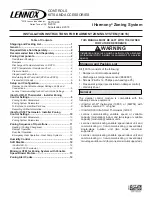
26
E-mail: [email protected]
Made in Rome, New York, USA
FREQUENTLY ASKED QUESTIONS
Q:
The system has just been installed using an EMI
indoor unit and a non-EMI condenser. There is no
display and the unit will not operate.
A:
When connecting an EMI evaporator to a non-EMI
condenser, a transformer may have to be added to
the system to provide 24V control power to the equip-
ment. Not all condenser manufactures supply a low
volt transformer with their condenser.
Q:
The condenser will not start although the indoor unit
appears normal. What should I do?
A:
At the indoor unit, make sure that the control is in
cooling and the setpoint temperature is below room
temperature. Then with a volt meter check for 24V
across the yellow (Y) and brown (C) wires. If 24V is
present then check for wiring breaks or improper con-
nections between the indoor and outdoor units.
A:
Some EMI condensers are equipped with a manual
reset high-pressure switch. It is located on the high
side of the system usually on the discharge line of
the compressor. To reset, simply push the red button
in. If the switch was tripped there will be a “click”
when it resets.
A:
If the unit is equipped with a condensate pump check
to see if the safety float has been tripped. This can
be done by first disconnecting both ends of the float
switch. Then with an Ohmmeter, check for continuity
across the switch. If the switch is open then the pump
is not clearing or the switch may be bad.
Q:
The display on the indoor unit is blank. What should
I do?
A:
Check the power supply (see “Power supply check”
Section). If the unit still fails to turn on via the
On/off
button then inspect the control box for any apparent
wires that may have come loose during shipping. Also
inspect the circuit boards for burnt components. If no
obvious problem can be found then replace all circuit
boards including the unit keypad. Do not attempt to
trouble shoot the individual circuit boards.
Q:
The display tends to flicker at times. Is this normal?
A:
A small amount of flickering of the display is normal.
Depending on the room lighting, flickering may be
more noticeable at some times than others.
Q:
How long will the fan run?
A:
While the unit is in cooling or heating and auto fan
mode is selected, Fan speed will be determined by
the microprocessor and speed adjustment will be
made according to room and setpoint temperatures.
The fan will switch to
High
speed when room tem-
perature deviates by more than two degrees from
setpoint. The fan will switch to
Low
speed if the de-
viation is one degree. When the room temperature
reaches setpoint temperature the heat/cool call is
dropped. The fan will then stay on for an additional
60 sec. to purge unit of any residual energy. If
High
or
Low
is selected then the fan will operate continu-
ous regardless of set point or room temperatures.
Q:
What causes my indoor unit to freeze-up?
A:
Evaporator freeze up is usually the symptom of an-
other problem. Your unit is equipped with freeze pro-
tection to prevent freeze up from occurring. If freeze
up does occur then check the following.
• Check that the freeze sensor located in the lowest
part of the coil. Generally this is where freeze up will
begin.
• Check that the freeze sensor inserted fully and snug
in the coil fin. If not another location may need to be
selected. Be careful not to insert the sensor directly
into the coil tube rather insert the sensor between
two tubes.
• Check the indoor air filter. It should be clean and free
of dirt. A dirty filter will reduce airflow and efficiency.
• Also check that the coil is clean. If the coil is dirty
then it should be cleaned using an appropriate coil
cleaner or mild detergent.
• Is the equipment being operated in cooling when
outdoor temperatures are below 65°F? If it is then
the condenser should be fitted with low ambient con-
trol so that the proper system pressures are main-
tained.
• Does the system have the proper refrigerant charge?
A system low on refrigerant can cause evaporator
freeze-up. To check system charge you will need to
contact a qualified refrigeration service technician.
Refrigerant charge information can be found in EMI’s
Condenser IOMs.
TROUBLESHOOTING PROCEDURE
Continued



































